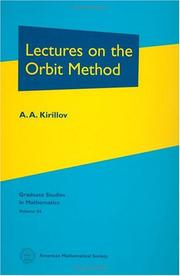| Listing 1 - 10 of 272 | << page >> |
Sort by
|
Book
Year: 1968 Publisher: Cambridge : Cambridge university press,
Abstract | Keywords | Export | Availability | Bookmark
 Loading...
Loading...Choose an application
- Reference Manager
- EndNote
- RefWorks (Direct export to RefWorks)
Book
Year: 1969 Publisher: Berlin : Springer,
Abstract | Keywords | Export | Availability | Bookmark
 Loading...
Loading...Choose an application
- Reference Manager
- EndNote
- RefWorks (Direct export to RefWorks)
Book
Abstract | Keywords | Export | Availability | Bookmark
 Loading...
Loading...Choose an application
- Reference Manager
- EndNote
- RefWorks (Direct export to RefWorks)
Book
Year: 1960 Publisher: Paris : Hermann,
Abstract | Keywords | Export | Availability | Bookmark
 Loading...
Loading...Choose an application
- Reference Manager
- EndNote
- RefWorks (Direct export to RefWorks)
Book
Year: 1968 Publisher: New York (N.Y.) : Academic press,
Abstract | Keywords | Export | Availability | Bookmark
 Loading...
Loading...Choose an application
- Reference Manager
- EndNote
- RefWorks (Direct export to RefWorks)
Book
Year: 1965 Publisher: New York (N.Y.) : Benjamin,
Abstract | Keywords | Export | Availability | Bookmark
 Loading...
Loading...Choose an application
- Reference Manager
- EndNote
- RefWorks (Direct export to RefWorks)

ISBN: 0821835300 Year: 2004 Publisher: Providence, R.I. : American Mathematical Society,
Abstract | Keywords | Export | Availability | Bookmark
 Loading...
Loading...Choose an application
- Reference Manager
- EndNote
- RefWorks (Direct export to RefWorks)
Multi
ISBN: 9780081023570 008102357X 1785482319 9781785482311 Year: 2018 Publisher: London, England ; Oxford, England : ISTE Press : Elsevier,
Abstract | Keywords | Export | Availability | Bookmark
 Loading...
Loading...Choose an application
- Reference Manager
- EndNote
- RefWorks (Direct export to RefWorks)
Multi-body Kinematics and Dynamics with Lie Groups explores the use of Lie groups in the kinematics and dynamics of rigid body systems. The first chapter reveals the formal properties of Lie groups on the examples of rotation and Euclidean displacement groups. Chapters 2 and 3 show the specific algebraic properties of the displacement group, explaining why dual numbers play a role in kinematics (in the so-called screw theory). Chapters 4 to 7 make use of those mathematical tools to expound the kinematics of rigid body systems and in particular the kinematics of open and closed kinematical chains. A complete classification of their singularities demonstrates the efficiency of the method. Dynamics of multibody systems leads to very big computations. Chapter 8 shows how Lie groups make it possible to put them in the most compact possible form, useful for the design of software, and expands the example of tree-structured systems. This book is accessible to all interested readers as no previous knowledge of the general theory is required.
Multi
ISBN: 9780128178027 0128178027 9780128178010 0128178019 Year: 2019 Publisher: London, United Kingdom : Academic Press, an imprint of Elsevier,
Abstract | Keywords | Export | Availability | Bookmark
 Loading...
Loading...Choose an application
- Reference Manager
- EndNote
- RefWorks (Direct export to RefWorks)
From Dimension-Free Matrix Theory to Cross-Dimensional Dynamic Systems illuminates the underlying mathematics of semi-tensor product (STP), a generalized matrix product that extends the conventional matrix product to two matrices of arbitrary dimensions. Dimension-varying systems feature prominently across many disciplines, and through innovative applications its newly developed theory can revolutionize large data systems such as genomics and biosystems, deep learning, IT, and information-based engineering applications.--
Book
ISBN: 0471941093 Year: 1993 Publisher: Chichester Wiley
Abstract | Keywords | Export | Availability | Bookmark
 Loading...
Loading...Choose an application
- Reference Manager
- EndNote
- RefWorks (Direct export to RefWorks)
Topological groups. Lie groups --- Conjugacy classes. --- Finite groups. --- Lie groups.
| Listing 1 - 10 of 272 | << page >> |
Sort by
|

 Search
Search Feedback
Feedback About UniCat
About UniCat  Help
Help News
News